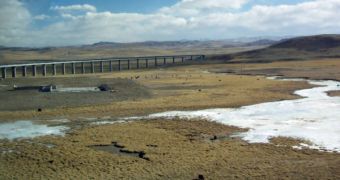The first half of the Qingzang railway, connecting mainland China to the Tibet Autonomous Region, was opened in 1984, when authorities inaugurated an 815-kilometer-long section of tracks, stretching from Xining to Golmud. The entire “iron road” was completed in 2006, when an additional 1142 kilometers were opened to the public, connecting Golmud to the Tibetan capital of Lhasa. With a total length of little under 2,000 kilometers (1,211 miles), the railway breaks a number of world records, including that for highest tunnel, highest pass, and highest train station owned. But a problem looms over the grandiose achievement, and that's global warming.
The problem is that 550 kilometers, or about 342 miles, of the entire length of the railways are built on permafrost, water-imbued soil that is always frozen. However, on account of global warming and climate change, officials fear that more than a quarter of the communication path could be affected by environmental changes. In addition to crumbling under the tracks and trains, and putting the passengers at risk of death, or serious injuries, the permafrost can also kill through methane emissions, which escape the ground when the superficial layers of ice melt.
“In Tibet, the mercury has climbed an average of 0.32 degrees Celsius every decade since records began in 1961. This is much higher than the national average temperature rise of 0.05-0.08 degrees Celsius every 10 years,” the official Xinhua news agency quotes Zheng Guoguang, the head of China's Meteorological Administration, as saying. Zheng has made the announcement while speaking at a meeting held in the Tibetan capital, Reuters reports. One of the main reasons why the region has been so prone to climate influences is the fact that Tibet is located at very high altitudes, which act like a “magnifier,” the official has explained.
“The impact of global warming has accelerated glacial shrinkage and the melting glaciers have swollen Tibet's lakes. If the warming continues, millions of people in western China would face floods in the short term and drought in the long run. In the worst case, such warming could cause permafrost to melt and threaten the plateau railway linking Tibet with the Qinghai province,” Zheng adds.
Over the last couple of years, China has announced on numerous occasions that it seeks to reduce its carbon footprint on the environment, but that it wishes to do so in a very sustainable manner, which means that it first has to ensure that no harm comes to its outstanding economic growth. According to estimates, if the current pace of warming continues in Tibet, the railway and a highway connecting the region with the rest of China could be completely destroyed within 40 years.

 14 DAY TRIAL //
14 DAY TRIAL //